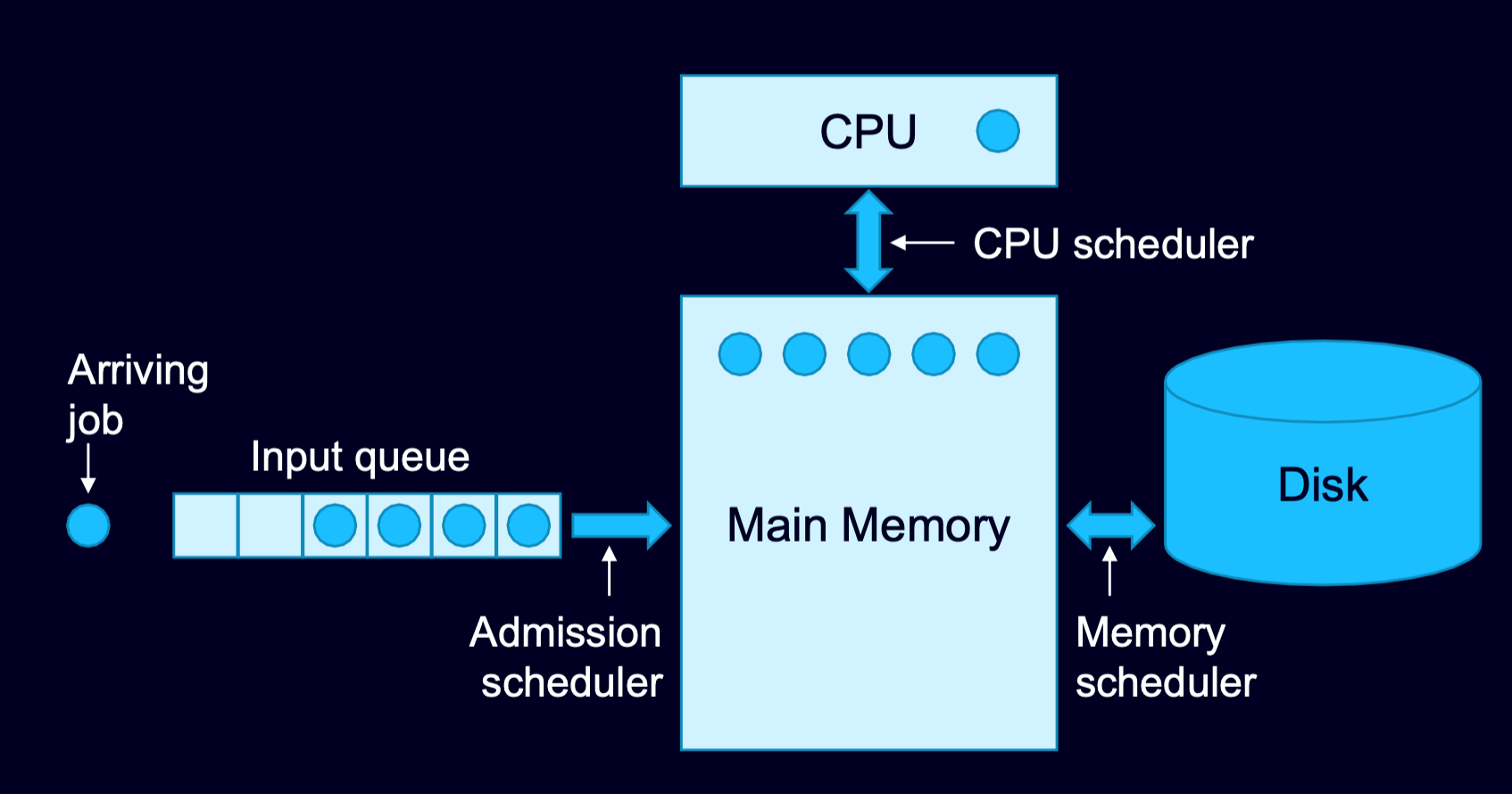The Scheduler
- The part of the OS that schedules when to run Processes
- Decides which project gets to run (and when)
- Is ready to respond after interrupts
- It has to know where to stop, where to restart
Implementation
- Quanta
- The unit of time that a process is allowed to run before moving onto the next process (typically fractions of a second)
- Can still be interrupted by a Hardware Interrupts
- Cycle
- Scheduler triggered → OS enters kernel mode
- Suspends the execution of the current process and saves its state into memory
- Loads the CPU registers with the states of the next process to execute and runs the new process
- The OS switches back to user mode
- The scheduler sets an alarm (with the length of a quanta) for the next switch
- When does the context switch
- Blocking Operations (Voluntary)
- CPU Yielding Operations (Voluntary)
- Gives up the rest of the time
- CPU Sharing (Involuntary)
- Asynchronous Events (Involuntary)
Algorithms
Non-Preemptive
- First-Come First-Serve
- Jobs run in order of arrival
- Simple but does not give the best results
- Shortest Job First
- Job that will finish first will run first
- Priority
- Job with highest priority is executed first
- Can use information about the tasks to set the priority and optimize over time
- Optimal (Crystal Ball)
- Uses future knowledge of arrivals for optimization
- Theoretical (base for comparison)
Preemptive
- Shortest Remaining Time First
- Ready job that will finish first runs first
- Would be optimal if there is no context switch cost
- Round Robin
- Has processes in a circular queue
- finishing running (and wanting to still run) or creation adds to the back of the queue
- Each process runs for some quanta of time
- Notated RR(quanta)
- It’s performance is connected to the process size and the size of the quanta
- Size of quanta is a balance
- Too short: Spends more time context switching (copying memory and stuff) than actually running the processes
- Too long: OS feels less interactive
- Preemptive Priority
- Ready job with highest priority is run first
- Uses multiple queues
- Exists in combinations with other strategies (such as round robin)
- Run all tasks in the queue with highest priority until they are done, and then move to the lower priority
- Problem: really low priority tasks never get to run (starve)
- Sometimes it’s okay if they just eventually run (fasting)
- Or some systems increase the priority of tasks that waited for a while
- Compatible Time-Sharing System
- Attempts to approximate SRTF
- Uses growing allocations and multiple priority queues
- Each time a process quanta ends, it adds two of itself to a lower priority queue
Proportionate
- Guaranteed
- If we have n processes, then we shouldn’t ever allow any process to exceed 1/n of the total runtime
- Lottery
- Each process gets “tickets” (can get multiple tickets for higher priority)
- Pick a ticket at random
- More tickets = higher probability of being selected
- Priority without starvation issues (because the ticket would eventually get chosen)
- Fair-Share Scheduling
- CPU time allocated per user, not process
- Can use lottery approach (and prioritize users by number of tickets)
Real-Time
- Static Schedule Priorities
- Priority of tasks don’t change
- Runs higher priority task first
- Is preemptive
- Dynamic Schedule Priorities
- Prioritizes scheduling according to the system’s deadlines
- Hard real time: missed deadline = disaster
- Soft real time: missed deadline = annoying
Modeling
- Coarse Approach
- We can do a very coarse measure of probability
- p = probability that one process is idle
- n = degree of multiprogramming (# of processes)
- pn = idle probability
- 1−pn = utilization
- Models don’t work that well because there is a big difference between theoretical and actual efficiency
Components

Long-Term: Admission Scheduler
- Goal is to maximize throughput
- Important for batch systems when there are jobs waiting
- Much longer quanta
- Question: Is there room in the system for another job? (good mix of jobs in RAM, CPU, esc.)
- Generally, not used in interactive systems because high latency
- Might be in interactive OS for low-load, background tasks
- ex: running a virus scan or backup overnight
Medium-Term: Memory Scheduler
- Checks memory load, decides what remains in memory and what goes back to storage
- Adds processes to memory or send them back to disk
- Question: Is memory taxed?
- Needs to work with the CPU scheduler to prevent processes from being moved back and forth too much (called thrashing)
Short-Term: CPU Scheduler
- Decides which process gets to be executed next in the CPU
- Runs super frequently → must execute fast
- Depends on priority and process history
Relationship to OS Types
- All
- Fairness: giving each process a fair share of the CPU
- Policy enforcement: seeing that stated policy is carried out
- Balance: Keeping all parts of the system busy
- Batch
- Throughput: Maximize jobs per hour
- Turnaround time: Minimize time between submission and termination
- CPU utilization: Keep the CPU busy at all times
- Can be preemptive or not
- Relies more on the admission scheduler
- Interactive
- Response time: Respond to request quickly
- Proportionality: Meets users expectations
- Almost always preemptive
- Real-Time
- Meeting deadlines: Avoid losing data
- Predictability: Avoid quality degradation
